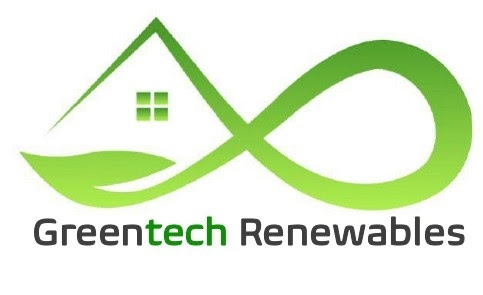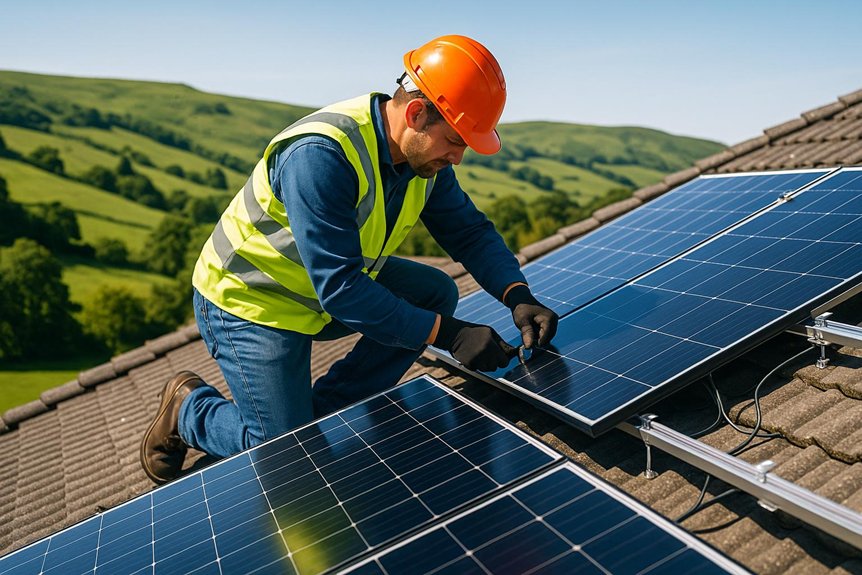If you install solar panels in Llandrindod Wells, you can cut up to £400 annually from your energy bills and boost your home’s market value. Modern panels use photovoltaic cells to convert sunlight into electricity with efficiencies over 22%, especially when paired with battery storage for better energy use. Local grants often reduce upfront costs, while certified installers guarantee proper setup for long-term performance. Exploring further reveals how these systems optimize savings and sustainability in your home.
Benefits of Solar Panel Installation in Llandrindod Wells
Although the initial installation of solar panels in Llandrindod Wells requires upfront investment, you can expect substantial financial benefits over time, including annual savings of up to £400 on energy bills due to decreased electricity consumption from the grid. Additionally, solar panels can increase your property’s market value, as energy-efficient homes attract higher demand. With modern photovoltaic panels achieving over 22% efficiency, you’ll generate significant energy even under variable weather conditions. The government offers grants and tax incentives that reduce your initial costs, making solar power more accessible. Moreover, these panels typically last beyond 25 years, providing long-term savings and requiring minimal maintenance. By investing in solar technology, you position yourself to benefit from both immediate and sustained economic advantages in Llandrindod Wells. Furthermore, government grants and tax incentives play a crucial role in making solar installations more affordable for homeowners.
How Solar Panels Work to Generate Electricity
You’ll find that solar panels generate electricity through the photovoltaic effect, where sunlight hitting semiconductor materials creates an electric current. This direct current (DC) then passes through an inverter, converting it into alternating current (AC) suitable for home use. Understanding this energy conversion process is key to grasping how solar panels efficiently transform sunlight into usable electricity. Additionally, the integration of high-performing battery storage enhances the overall efficiency and reliability of the solar power system.
Photovoltaic Effect Explained
When sunlight strikes the semiconductor materials within a solar panel, photons transfer their energy to electrons, causing these electrons to become excited and generate direct current (DC) electricity through the photovoltaic effect. This process is fundamental to solar energy generation and efficiency. Here’s what you should know:
- Photovoltaic panels use semiconductors, typically silicon, to capture sunlight and free electrons.
- The excited electrons flow as DC electricity, which requires conversion for household use.
- Factors such as panel material (monocrystalline or polycrystalline), orientation, and sunlight exposure affect efficiency, often exceeding 22%.
- Solar panels are built for longevity, with warranties up to 25 years, ensuring sustained performance with minimal maintenance.
Understanding this effect clarifies how solar panels transform sunlight into usable electricity efficiently.
Energy Conversion Process
Having established how the photovoltaic effect generates direct current (DC) electricity within solar panels, it’s important to understand how this electricity becomes usable for your home or the power grid. The DC electricity produced by the panels flows into an inverter, which converts it into alternating current (AC). This AC electricity matches the power used in your home and the grid. Factors like panel orientation, sunlight exposure, and weather impact the energy conversion efficiency, which can exceed 22% with modern panels. Below is a summary of key elements in the energy conversion process:
| Component | Function | Impact on Efficiency |
|---|---|---|
| Photovoltaic Cell | Generates DC electricity | Determines initial output |
| Inverter | Converts DC to AC electricity | Efficiency affects power quality |
| Sunlight Exposure | Provides energy input | Directly proportional to output |
| Panel Orientation | Optimizes sunlight absorption | Enhances overall performance |
Choosing the Right Solar Panel Technology
When choosing solar panel technology, you need to take into account efficiency differences, since monocrystalline panels generally outperform polycrystalline ones with over 22% efficiency. Additionally, ideal placement matters; installing panels facing south in the Northern Hemisphere maximizes sunlight exposure and energy output. By evaluating both panel efficiency and positioning, you can greatly improve your system’s overall performance. Furthermore, considering the cost of hiring a solar panel installer can help you budget effectively for your solar energy project.
Panel Efficiency Comparison
Although various solar panel technologies are available, understanding their efficiency differences is essential when choosing the right system for your needs. Here’s a comparison to guide your decision:
- Monocrystalline panels convert over 22% of sunlight, making them highly efficient and suitable for limited roof space.
- Polycrystalline panels offer 15%-20% efficiency, are less costly, but require more surface area to produce the same energy.
- Weather conditions like cloud cover and shading can reduce panel efficiency, so site assessment is vital.
- Advanced options like bifacial panels and tracking systems can boost energy capture by utilizing sunlight from multiple angles.
Considering these factors will help you select a system that balances efficiency, cost, and installation constraints effectively.
Optimal Panel Placement
Ideal solar panel placement hinges on several critical factors, including orientation, tilt angle, and local environmental conditions. To maximize sunlight exposure, you should position panels facing south in the Northern Hemisphere, such as in Llandrindod Wells. The tilt angle is equally important; setting it between 30° and 40° often optimizes sunlight capture based on geographic location. You’ll also want to take into account panel technology—monocrystalline panels, with efficiencies exceeding 22%, outperform polycrystalline types. Weather conditions greatly impact output, so avoid shaded or cloudy areas when selecting your installation site. Additionally, advanced tracking systems can increase energy production by adjusting panels to follow the sun’s path throughout the day. Taking these factors into account guarantees your solar array operates at peak efficiency year-round.
Understanding Battery Storage Solutions
Because solar panels generate energy primarily during daylight hours, integrating battery storage solutions becomes essential for maximizing the utility of this renewable resource. Battery systems store surplus energy for use at night or peak times, increasing overall efficiency. When you install battery storage with your solar panels, you gain several advantages:
- Store excess solar energy for later use, reducing waste.
- Increase energy independence and maintain power during outages.
- Monitor real-time data on production and consumption for better management.
- Benefit from advanced features like remote programming and automatic updates, ensuring long-term efficiency.
Financial Incentives and Grants Available Locally
Integrating battery storage with solar panels maximizes energy efficiency, but understanding the financial incentives available in your area can further improve the overall cost-effectiveness of your installation. In Llandrindod Wells, you can access various government grants and tax incentives designed to lower the upfront costs of solar panel systems. Local rebate programs and low-interest loans also make adopting solar technology more affordable. Additionally, the Smart Export Guarantee (SEG) in Wales allows you to earn payments for surplus energy you export to the grid, enhancing your return on investment. These financial benefits often accelerate the payback period, enabling substantial savings on energy bills within a few years. Furthermore, installing solar panels can increase your property’s value by improving its recognized energy efficiency.
The Installation Process and What to Expect
Before any physical work begins, a thorough site assessment is conducted to determine your property’s suitability for solar panel installation, taking into account factors such as roof orientation, shading, and structural integrity; this evaluation guarantees that the system will perform efficiently once installed. The installation process involves several key steps:
- Certified technicians mount the solar panels on your roof or ground, ensuring secure placement.
- They connect the panels to an inverter, which converts solar energy into usable electricity.
- Integration with your home’s electrical grid follows, allowing seamless energy distribution.
- Finally, a detailed inspection verifies all components function correctly, and you receive operational guidelines.
The entire process typically takes one to three days, with post-installation support available to maintain system performance over time.
Enhancing Energy Efficiency in Your Home
Following the installation process, attention shifts to how solar panels can substantially improve your home’s energy efficiency. By converting over 22% of sunlight into electricity, modern photovoltaic panels guarantee peak energy production tailored to your household needs. This improvement can reduce your electricity bills by up to £400 annually, reflecting significant savings. Additionally, solar systems last over 25 years, offering durable energy solutions and less dependence on traditional power sources. Government grants and tax benefits further ease the financial investment, while increased energy efficiency can enhance your property value.
| Benefit | Impact | Duration |
|---|---|---|
| Electricity Savings | Up to £400 annually | Immediate |
| Energy Conversion Rate | Over 22% sunlight to power | Continuous |
| System Lifespan | 25+ years | Long-term |
Long-Term Savings and Environmental Impact
Although the upfront investment in solar panel installation may seem substantial, you can expect considerable long-term savings primarily through reduced energy bills, which in Llandrindod Wells can reach up to £400 annually. Over a lifespan exceeding 25 years, these savings accumulate markedly. Additionally, solar panels:
- Increase your property value, as energy-efficient homes attract buyers.
- Benefit from government grants, tax incentives, and rebates that lower initial costs.
- Provide a reliable source of renewable energy, reducing your dependence on fossil fuels.
- Substantially cut your carbon footprint, contributing to environmental sustainability.
Selecting Certified Solar Installers in Llandrindod Wells
When choosing certified solar installers in Llandrindod Wells, you’ll want to prioritize those accredited by recognized industry bodies, as this certification guarantees adherence to established standards and regulations. Make certain the installer offers extensive aftercare and support services, which are essential for maintaining your system’s efficiency over time. Check customer testimonials to assess their reliability, punctuality, and service quality. Inquire about the types of solar panels provided, focusing on those with efficiency ratings above 22% to guarantee peak energy conversion. Additionally, confirm that the installer conducts a detailed site assessment tailored to your property’s unique energy requirements and characteristics. This thorough evaluation helps customize the installation, maximizing performance and long-term savings while complying with local guidelines.


